- Qualcomm Launches Snapdragon 4 Gen 2 Mobile Platform
- AMD Launches Ryzen PRO 7000 Series Mobile & Desktop Platform
- Intel Launches Sleek Single-Slot Arc Pro A60 Workstation Graphics Card
- NVIDIA Announces Latest Ada Lovelace Additions: GeForce RTX 4060 Ti & RTX 4060
- Maxon Redshift With AMD Radeon GPU Rendering Support Now Available
ASUS Xonar DX 7.1 Sound Card
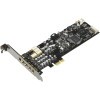
ASUS finally antes up to the bang-for-the-buck table with a value-priced product in their Xonar family of performance audio cards. It’s got a solid feature set, and debuts with ASUS’ new DS3D GX 2.0 environmental DSP, but does it break new ground in the price/performance department?
Page 3 – Features Overview
The ASUS Xonar DX sound card is a value-oriented relative of the reference-quality Xonar D2 and D2X cards, but that doesn’t mean that ASUS has gone light on the feature set of this attractive new option in the price/performance race. Let’s take a look at the design features of the Xonar DX sound card. Has ASUS made any performance-hobbling engineering tradeoffs in their pursuit of the price/performance crown?
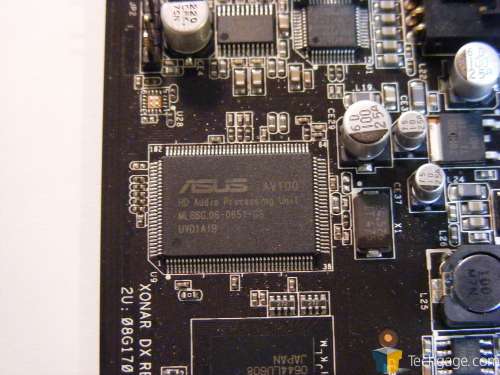 |
Let’s start with the heart of the Xonar DX – the ASUS AV100 audio processor. Though it bears a different model designation, it’s still a rebranded C-Media CMI-8788 OxygenHD audio processor – in fact, it’s the very same one that’s at the core of the Xonar D2 and D2X sound cards, though these units didn’t test at the higher 118dB SNR spec, so they fit within a lower 116dB specification ‘bin’, in much the same way that CPUs with the same physical core might ‘bin’ at different maximum stable frequencies.
The signal-to-noise ratio of the audio processor may be dependent upon slight variations in the manufacturing process that affect noise infiltration at various stages in the internal signal chain, so rather than reject these parts, ASUS has elected to use them in their value-priced offerings. Of course, ASUS’ decision to re-brand an off-the-shelf audio chipset is one I’m willing to endorse here, especially since the CMI8788 boasts specs that embarrass many competing current-generation audio processors.
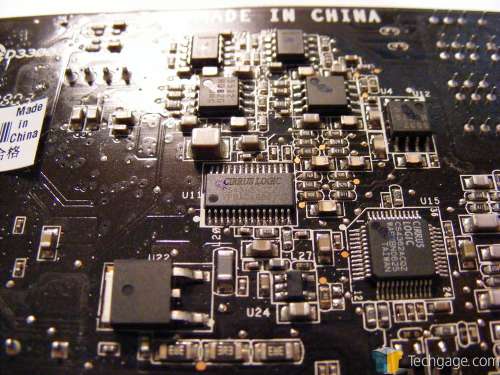 |
The next place to look for differences between the Xonar DX and its higher-priced siblings is in the DACs, or Digital-to-Analog Converters. These ICs are responsible for converting the digital output of the audio processor to an analog signal that may be fed into the output-stage opamps, and can have a significant effect on audio quality.
In the case of the Xonar DX, ASUS foregoes the reference-quality Burr-Brown DACs of the D2 and D2X for less-expensive Cirrus Logic DACs. Where the eight channels of the Xonar D2 and D2X were handled by a tandem pair of Burr-Brown PCM1796 four-channel DACs, the front left and right channels of the Xonar DX are handled by a Cirrus Logic CS4398 stereo DAC (120dB dynamic range), while the other six channels are handled by a Cirrus Logic CS4362A 6-channel DAC (114dB dynamic range).
On the Line In side of things, the Xonar DX uses a Cirrus Logic CS5361 ADC (114dB dynamic range). (For those of you sharp enough to decipher ADC as Analog-to-Digital Converter, good for you – it’s a DAC in reverse.) While the Burr-Brown parts on the Xonar D2 and D2X are likely to be found in high-end, high-dollar audiophile stereo gear, the Cirrus Logic parts are of a more mass-market nature, and significantly less expensive in quantity.
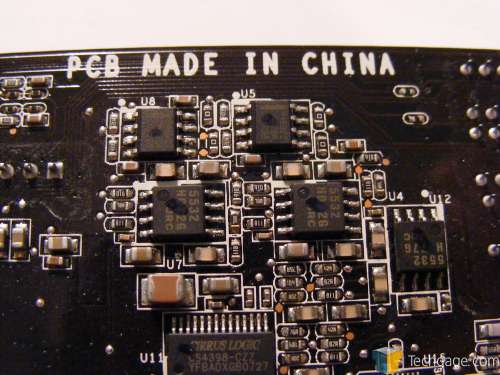 |
Instead of the Burr-Brown OPA237 opamps used in the analog output stage of the Xonar D2 and D2X cards, the Xonar DX gets by with more plain-vanilla Texas Instruments 4580 opamps (0.0005% THD) for the front left and right channels, and TI 5532 low-noise opamps for the other six channels. All of the Xonar D2’s output-stage opamps are located on the back face of the PCB, along with their corresponding DACs.
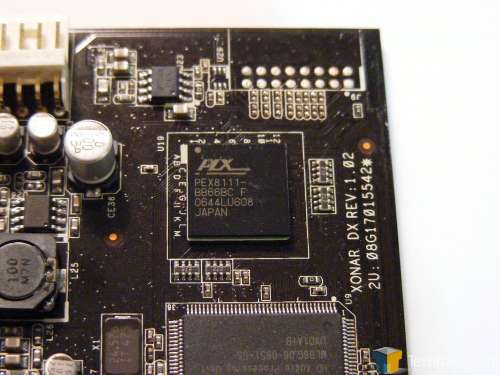 |
The CMI8788 audio processor isn’t designed for communication across the PCI-Express bus, so short of holding C-Media’s feet to the fire to develop a PCI-E audio chipset, ASUS chose instead to pair the AV100 with a PLX PEX8111 PCI-Express bridge chip, which creates a single-channel PCI bus on the card itself and allows the Xonar DX to function as a PCI Express device.
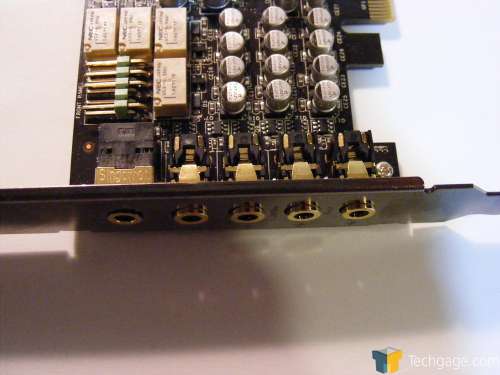 |
The input panel of the Xonar DX card has five 3.5mm stereo mini-jacks, which are gold-plated for low-resistance conductivity. Preferring substance over bling in this price category, the Xonar DX’s jacks lack the multicolor illumination of the D2 and D2X, so you might need a flashlight when hooking up the Xonar DX in a low-light area. In this photo, the left-most input jack also contains an optical signal transmitter, for use with the supplied Toslink-to-Mini-Optical connector if you use Toslink cables (like most of the audio industry today).
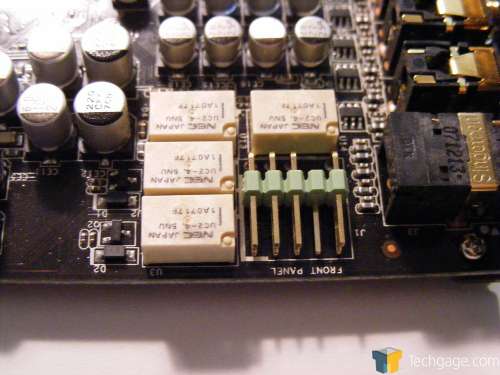 |
One more notable difference between the Xonar DX and its more expensive brethren is that it features a front-panel audio I/O header. The D2 and D2X omitted this feature, much to the consternation of some purchasers – though a quick look at my Creative Sound Blaster X-Fi XtremeGamer card revealed that it, too, lacked a front panel I/O header. The four cream-colored objects on the PCB surrounding the front panel header are actually quad-pole relays that switch mechanically from the rear panel I/O ports to the front panel header when a device is plugged in.
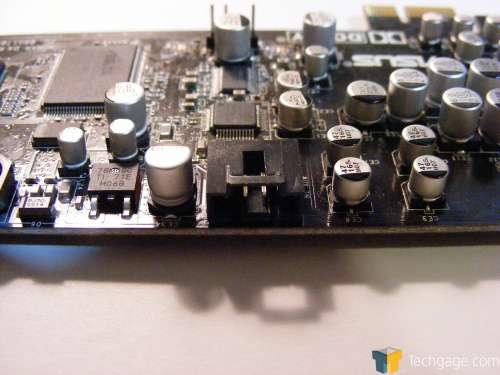 |
The Xonar DX also provides a single 4-pin audio input header, for use with older CD-ROM drives that have direct analog audio outputs. There’s not much reason to worry about one of these, nowadays (with most audio being handled digitally via software) – but the Xonar DX provides one, for an added measure of flexibility. One feature that’s missing from the DX that’s present on the D2 and D2X, however, is the ALT (Analog Loopback Transformation) feature, which would automatically create a direct path on the circuit board between the analog outputs and the analog line-input.
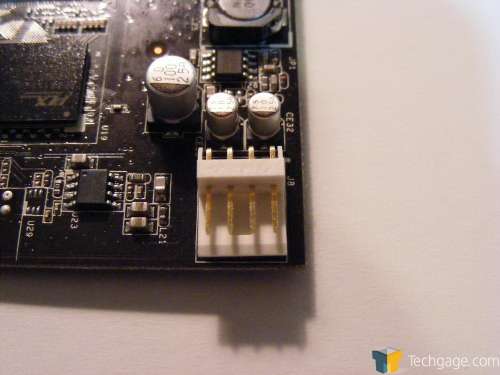 |
One final thing to mention on the hardware side – the Xonar DX requires an additional 4-pin Berg (floppy-style) power connector. I’m not sure why the PCI Express 1x connector would fall short when it comes to the card’s power requirements – the PCI version of the Xonar D2 had no need of any additional power supply besides what it could draw from its PCI slot connector.
Still, be sure you’ll be able to meet this additional requirement – the Xonar DX won’t function without it. The X-Fi Fatal1ty XtremeGamer Professional Edition card I had on hand also has a 4-pin power connector, but functions just fine without it, I found, but the same is not the case for the Xonar DX.
We’ve just taken an intensely technical look at the design of the ASUS Xonar DX sound card – but how does its feature set translate into performance? We’ll take the card for a spin shortly, after a brief word about the software drivers.
Support our efforts! With ad revenue at an all-time low for written websites, we're relying more than ever on reader support to help us continue putting so much effort into this type of content. You can support us by becoming a Patron, or by using our Amazon shopping affiliate links listed through our articles. Thanks for your support!




